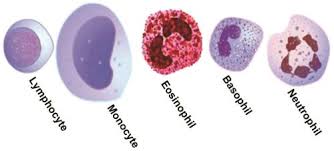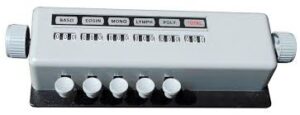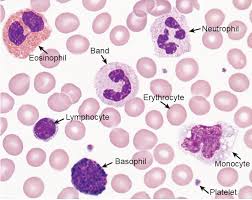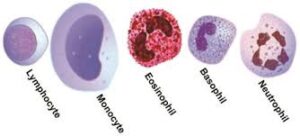
Principle
- DLC ka principle hai blood smear ka microscopic examination, jise specific dyes (jaise Wright’s stain ya Giemsa stain) se stain kiya jaata hai.
- Yeh stains alag-alag types ke leukocytes ko distinguish karne mein madad karte hain.
- Har ek WBC type ka nucleus (size, shape, aur lobes ki number) aur cytoplasm ke features unique hote hain, jo inhe identify karne mein madad karte hain.
- DLC test mein har type ka WBC count karke unka percentage total WBC count ke hisaab se diya jaata hai.
- Zyada accurate result ke liye 100-200 cells ka count kiya jaata hai.
- Yeh test immune system ke state ke baare mein valuable information deta hai, jo kai diseases aur conditions ko diagnose karne mein madad karta hai.
Requirements
-
Microscope: Compound microscope
-
Staining Solutions: Commonly used stains Wright’s stain aur Giemsa stain.
-
Glass Slides
-
Pipette: Blood ko slide par transfer karne ke liye pipette ka use hota hai.
-
Counter ya automated system.

Procedure
DLC procedure mein kai steps hote hain, jo blood collection se leke microscopic examination aur counting tak ka process cover karte hain. Yeh raha detailed breakdown:
Step 1: Blood Smear ki Preparation
-
Blood ka ek chhota drop clean glass slide par rakhte hain.
-
Dusri clean slide ko 30–45 degree angle par rakh kar blood drop ko spread karte hain, taaki ek thin aur even layer of blood slide par ho jaye.

-
Smear ko jaldi aur evenly spread karna zaroori hai, taaki cells clump na ho aur smear na zyada thick ho jaye, jo examination mein mushkil kar sakta hai.
Step 2: Blood Smear ka Staining
-
Blood smear ko Wright’s stain ya Giemsa stain mein kuch minutes ke liye rakhte hain. Yeh stains alag-alag leukocytes ko clearly differentiate karne mein madad karte hain.
-
Staining ke baad, smear ko water se gently wash karte hain taaki excess stain nikal jaye.
-
Smear ko phir se air dry hone dete hain.
Step 3: Microscope ke Under Examination
-
Stained smear ko microscope ke stage par rakhte hain aur initially low magnification (10x ya 40x) se scan karte hain, taaki ek area choose kiya ja sake jahan cells ka spread perfect ho (na zyada thick, na zyada thin).
-
Phir oil immersion (100x) lens ka use karte hain, jahan WBCs clearly observe kiye ja sakte hain aur unke morphological features (size, shape, staining pattern) ko assess kiya ja sakta hai.
Step 4: White Blood Cells ki Identification
-
Oil immersion lens mein, har ek WBC ko carefully observe kiya jaata hai aur classify kiya jaata hai based on uske distinct characteristics. Classification kuch is tarah hoti hai:
-
Neutrophils: Inka multi-lobed nucleus hota hai (2-5 lobes), aur pale cytoplasm with fine granules. Yeh cells primarily bacterial infections ke defense mein involved hote hain.
-
Lymphocytes: Inka large, round nucleus hota hai, jo cell ka majority part occupy karta hai, aur around ek thin rim of cytoplasm hota hai. Yeh cells adaptive immunity aur viral infections ke response mein involved hote hain.
-
Monocytes: Yeh sabse bade WBCs hote hain, inka kidney-shaped nucleus aur abundant cytoplasm hota hai. Yeh cells macrophages mein mature hote hain aur phagocytosis mein involved hote hain.
-
Eosinophils: Inka bi-lobed nucleus hota hai aur red ya orange granules cytoplasm mein hote hain. Yeh cells allergic reactions aur parasitic infections ke response mein involved hote hain.
-
Basophils: Yeh sabse kam common WBCs hote hain, inmein blue ya purple granules hote hain. Yeh cells allergic reactions aur inflammation mein involved hote hain.

-
Step 5: Counting aur Reporting
-
Kam se kam 100–200 white blood cells count kiye jaate hain taaki har type ke WBCs ka accurate percentage mil sake.
-
Har type ke WBC ka number record kiya jaata hai, aur uska percentage calculate kiya jaata hai total WBC count ke hisaab se.
-
Kabhi-kabhi absolute counts bhi calculate kiye jaate hain, jo har WBC type ke percentage ko total WBC count se multiply kar ke nikala jaata hai.
Step 6: Reporting
-
DLC ka result percentage mein report hota hai (jaise Neutrophils: 60%, Lymphocytes: 30%, etc.). Kuch cases mein absolute values bhi diye jaate hain.
-
Agar koi type of WBC ka count normal se zyada ya kam ho, toh uska significance mention kiya jaata hai, kyunki yeh kisi underlying medical condition ko indicate kar sakte hain.
Clinical Significance
DLC test se humein patient ke immune system ke baare mein important information milti hai aur yeh various conditions ko identify karne mein madad karta hai, jaise infections, inflammatory diseases, allergic reactions, aur hematologic disorders. Har WBC type ka clinical significance kuch is tarah hota hai:
Neutrophils:
-
Neutrophilia (Neutrophils ka increase): Neutrophil count increase ho sakta hai bacterial infections, inflammatory conditions, stress, ya tissue damage (jaise burns) ke response mein.
-
Neutropenia (Neutrophils ka decrease): Neutrophil count kam ho sakta hai viral infections (jaise influenza, HIV), bone marrow disorders, ya chemotherapy ke wajah se.
Lymphocytes:
-
Lymphocytosis (Lymphocytes ka increase): Lymphocyte count increase ho sakta hai viral infections (jaise mononucleosis, hepatitis), chronic lymphocytic leukemia (CLL), aur whooping cough ke case mein.
-
Lymphopenia (Lymphocytes ka decrease): Lymphocyte count decrease ho sakta hai immunodeficiency, corticosteroid use, ya HIV infection ke wajah se.
Monocytes:
-
Monocytosis (Monocytes ka increase): Monocyte count increase ho sakta hai chronic infections (jaise tuberculosis, brucellosis), inflammatory disorders (jaise systemic lupus erythematosus), aur leukemia (jaise chronic myelomonocytic leukemia).
-
Monocytopenia (Monocytes ka decrease): Monocyte count kam hona rare hai, lekin bone marrow disorders, corticosteroid use, aur kuch viral infections mein ho sakta hai.
Eosinophils:
-
Eosinophilia (Eosinophils ka increase): Eosinophil count increase ho sakta hai allergic reactions (jaise asthma, hay fever), parasitic infections (jaise hookworm, roundworm), aur kuch autoimmune conditions mein (jaise eosinophilic granulomatosis).
-
Eosinopenia (Eosinophils ka decrease): Eosinophil count ka decrease usually stress, acute infection, ya corticosteroid therapy ke wajah se hota hai.
Basophils:
-
Basophilia (Basophils ka increase): Basophil count increase ho sakta hai chronic myelogenous leukemia (CML), hypersensitivity reactions, aur chronic inflammation mein.
-
Basopenia (Basophils ka decrease): Basophil count ka decrease usually acute infection ya stress ke wajah se hota hai.
